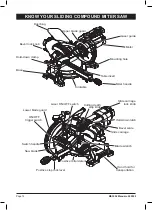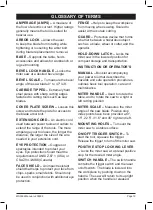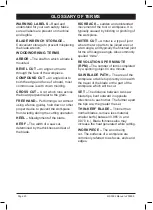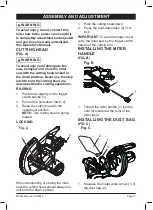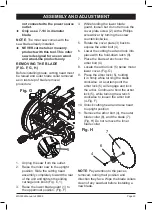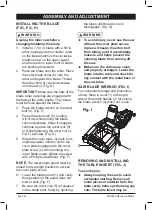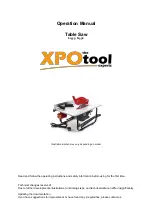
MS3002 Manual v.200909
Page 9
POWER TOOL SAFETY
GENERAL SAFETY
INSTRUCTIONS
BEFORE USING THIS POWER TOOL
Safety is a combination of common
sense, staying alert and knowing how to
use your power tool.
WARNING
To avoid mistakes that could cause
serious injury, do not plug the tool in
until you have read and understood
the following.
1.
READ
and become familiar
with the entire Operator’s
Manual. LEARN the tool’s
application, limitations and possible
hazards.
2.
KEEP GUARDS IN PLACE
and
in working order.
3.
REMOVE ADJUSTING KEYS
AND WRENCHES. Form the habit
of checking to see that keys and
adjusting wrenches are removed
from the tool before turning ON.
4.
KEEP WORK AREA CLEAN.
Cluttered areas and benches invite
accidents.
5.
DO NOT USE IN DANGEROUS
ENVIRONMENTS.
Do not use
power tools in damp locations, or
expose them to rain or snow. Keep
work area well lit.
6.
KEEP CHILDREN AWAY.
All
visitors and bystanders should be
kept a safe distance from work area.
7.
MAKE WORKSHOP CHILD
PROOF
with padlocks, master
switches or by removing starter
keys.
8.
DO NOT FORCE THE TOOL.
It
will do the job better and safer at the
rate for which it was designed.
9.
USE THE RIGHT TOOL.
Do not
force the tool or an attachment to do
a job for which it was not designed.
10.
USE PROPER EXTENSION
CORDS.
Make sure your extension
cord is in good condition. When
using an extension cord, be sure
to use the one heavy enough to
carry the current that the product
will draw. An undersized cord will
result in a drop in line voltage and in
loss of power which will cause the
tool overheat. The table on page 11
shows the proper wire gauge size
usage to each extension cord length
and ampere rating. If in doubt, use
the next heavier gauge. The smaller
the gauge number, the heavier the
cord.
11.
WEAR PROPER APPAREL.
Do not wear loose clothing, gloves,
neckties, rings, bracelets or other
jewelry which may get caught in
moving parts. Nonslip footwear is
recommended. Wear protective hair
covering to contain long hair.
12.
ALWAYS WEAR EYE
PROTECTION.
Any power
tool can throw foreign
objects into the eyes and could
cause permanent eye damage.
ALWAYS wear Safety Goggles (not
glasses) that comply with ANSI.
NOTE:
Glasses or goggles not in
compliance with ANSI Z87.1 could
seriously injure you when they
break.
13.
WEAR A FACE MASK
OR DUST MASK.
Sawing
operation produces dust.


















